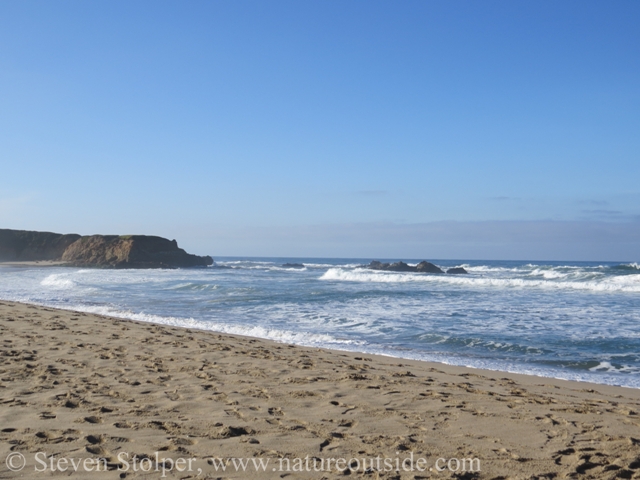
In part 1, our intrepid group of trackers deciphered signs left by a Harbor seal that hauled-out on the beach for several hours. As our group moves south, we encounter the mouth of Pescadero Creek. The creek flows across the beach at the base of large sandstone bluffs that extend into the ocean. Time and the elements have created a natural “bridge”, an archway through the stone leading to another part of the beach.
We follow the creek upstream with intentions of entering the marsh. We cross underneath the Pacific Coast Highway, but never actually reach the marsh proper. There is too much to see!
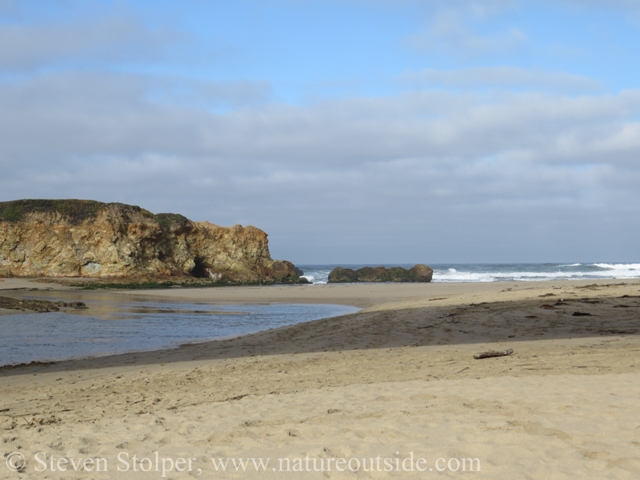
Looking toward the sea from underneath the highway overpass. Pescadero Creek flows over the sand on its way to the ocean.
Excited trackers flitter between track and sign, like sparrows gobbling seeds squirrels spill from a bird feeder. Anyone timing our progress toward the marsh would need a calendar.
But that is some of the charm of animal tracking. Within 30 yards were signs of at least 5 animal species. If you know what to look for, nature can engage your mind and senses without even having to break a sweat.
Fishy Poop
Three of our group kneel beside two small scats on the sand alongside the creek. My first thought is “domestic dog.” But my first thought is always “domestic dog” anywhere that people might bring them. And this was a state beach just feet from the highway.
I bend down to examine the scat, looking for hair, bones, a tapering end, anything that might indicate it was from a wild carnivore. I find none.
But it has an unusual consistency. It does not look quite like anything I have seen before. “Harbor seal scat smells fishy,” one of the guys explains.
I hesitated. From my California Naturalist capstone project, I was aware of the hazards of smelling scat. I wanted no part of Echinococcus tapeworms, Baylisascaris roundworms, or worse!
But as I adjusted my position I had no choice. The sea breeze carried the pungent odor right smack into my face. Yuck! The smell reminded me of sea kayaking past a colony of sea lions. The odor was sweaty, musky, and undoubtedly “marine.”
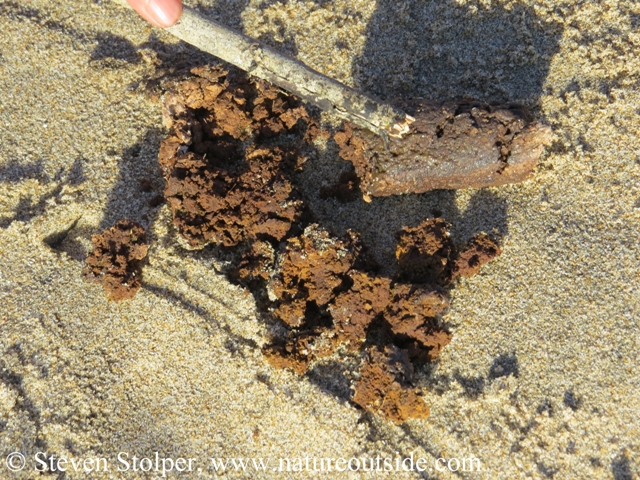
Harbor seal scat. It tends to be tubular if the seal was eating crabs, shellfish or certain fish (Elbroch)
We used a stick to break apart the scat, looking for more information. “A scale!” One of the trackers exclaims. Looking carefully, she had found a fish scale in the feces. This settled the matter in my mind.
Racoon Tracks
I love seeing raccoon tracks. I love the miniature “hand prints” with long dexterous fingers on the front paws. I love their characteristic pace walk and the unique trail it leaves behind.
Conditions on the beach were the best I have ever seen for looking at raccoon tracks. To be any more ideal, the animals would have to walk out of the bushes and plop down in front of my camera for a close up.
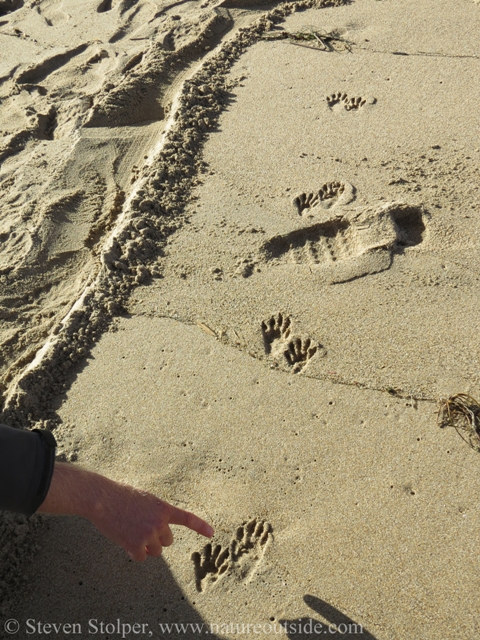
Ideal raccoon tracks. I wish I had my casting plaster!
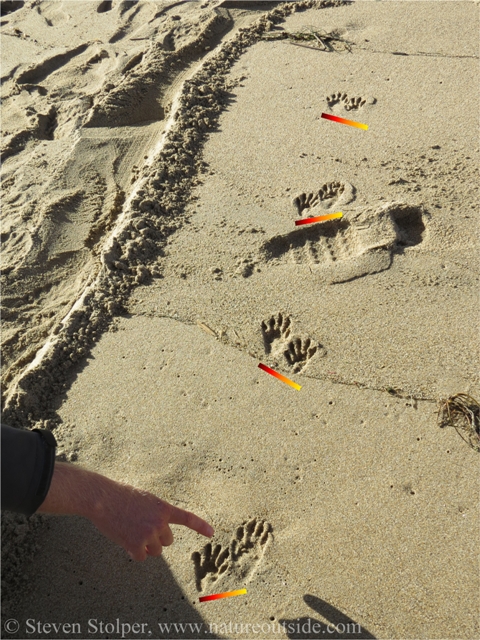
A raccoon’s pace walk leaves an alternating diagonal pattern. I believe the last track indicates a gait change.
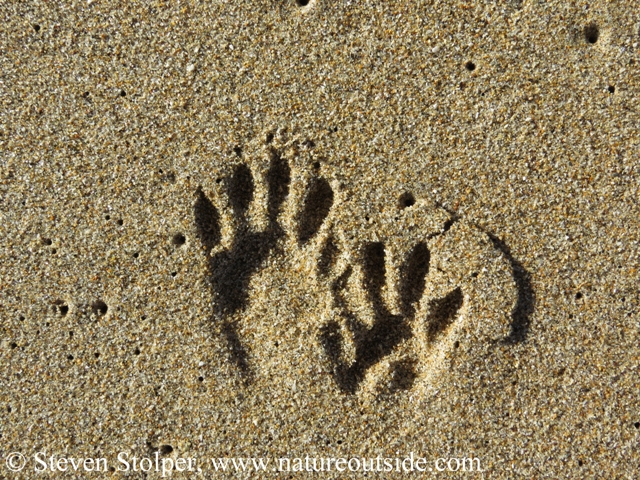
A close up of the tracks. I think the racoon was changing speed when it made this track.
Heron or Egret?
We also found the large tracks of a wading bird. Was it a Great Blue Heron or a Great Egret?
One characteristic of Great Blue Heron tracks is the degree to which the track is asymmetric. Herons have anisodactyl feet, one toe points backward. This toe is called the hallux. With Great Blue Herons, their hallux is offset (to the inside of the bird) from the centerline of the track. It is really quite dramatic.
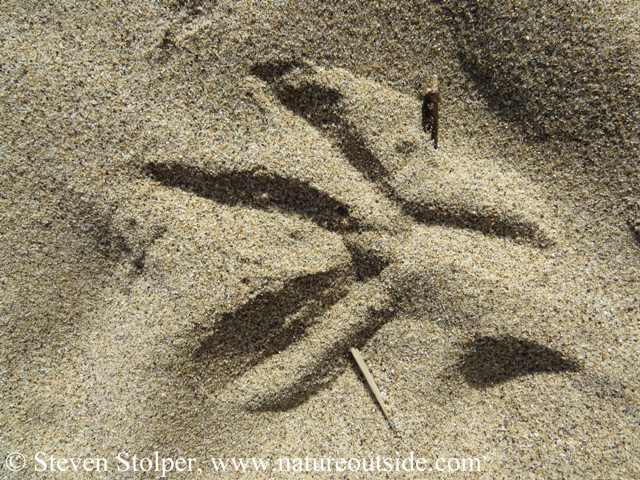
Great Blue Heron track
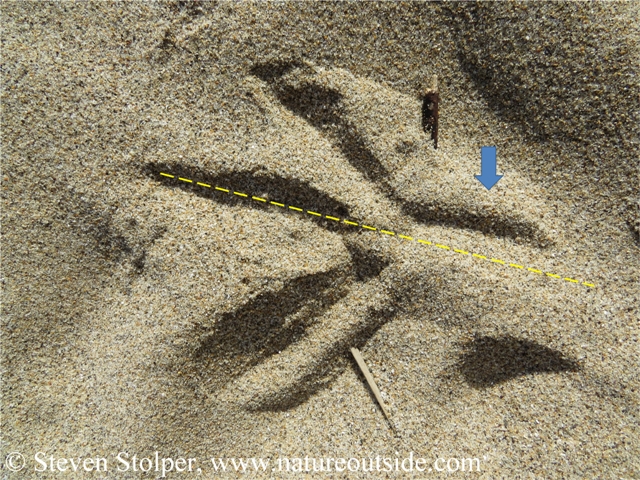
Notice how the hallux is “displaced” from the axis of symmetry. It is toward the center of the animal. I have been told that the outer toe tends to spread farther than the inner one.
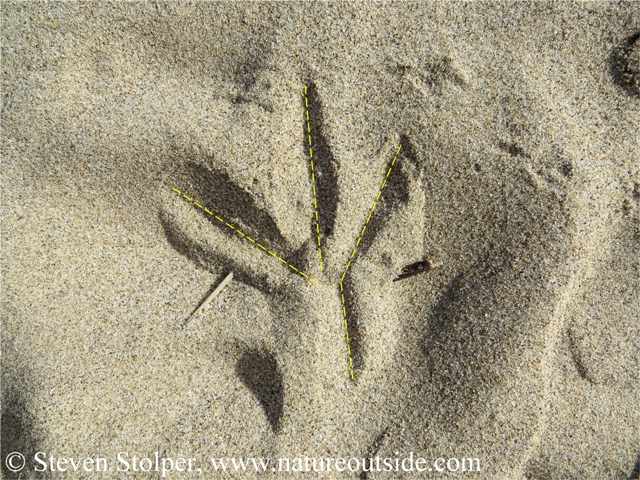
Another view from above showing the asymmetry
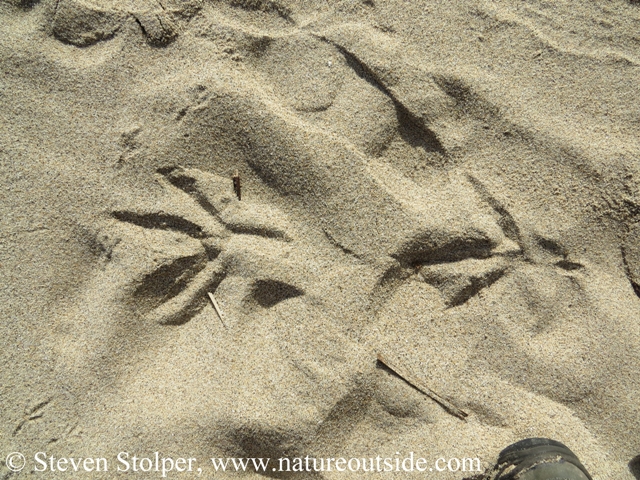
To the left of the picture is a left track. The track to the right of the picture is a right track.
Raven or Crow?
We also saw tracks we believed to be Raven or Crow. But how to tell the difference? Raven tracks are usually larger. But more importantly, the digital pad on the hallux closest to the metatarsal has a trapezoidal shape wider than the toe. A member of our group described it as an “ice cream cone.”
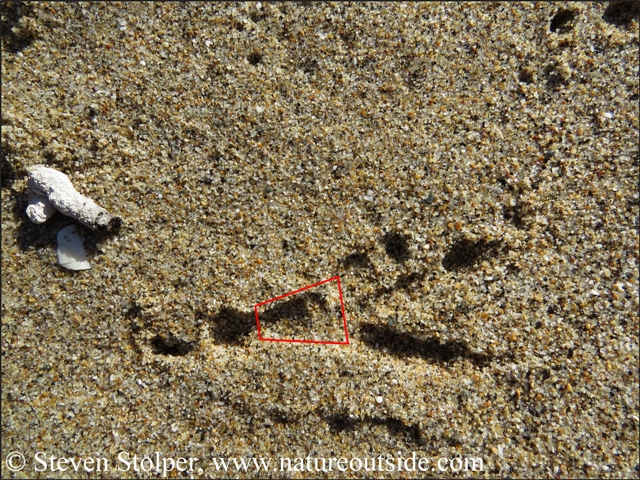
The digital pad on the hallux closest to the metatarsal has a trapezoidal shape wider than the toe.
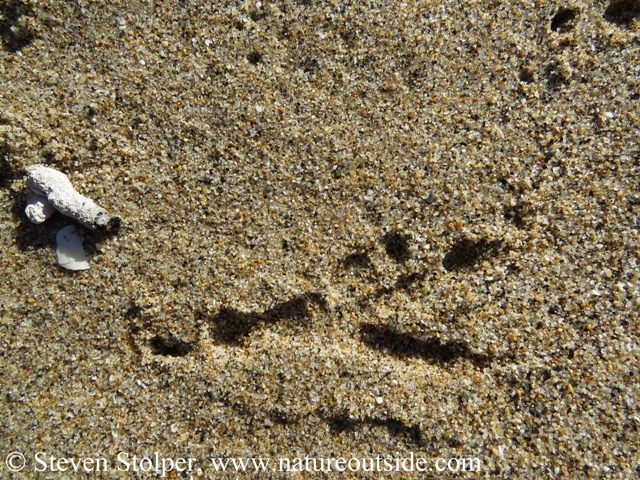
Can you see the “ice cream cone” in this Raven track?
Ducks or Gulls?
Several of us examined tracks along the creek made by a bird with webbed feet. But were they ducks or gulls? Unfortunately, I did not have time to examine the tracks and settled for a quick picture.
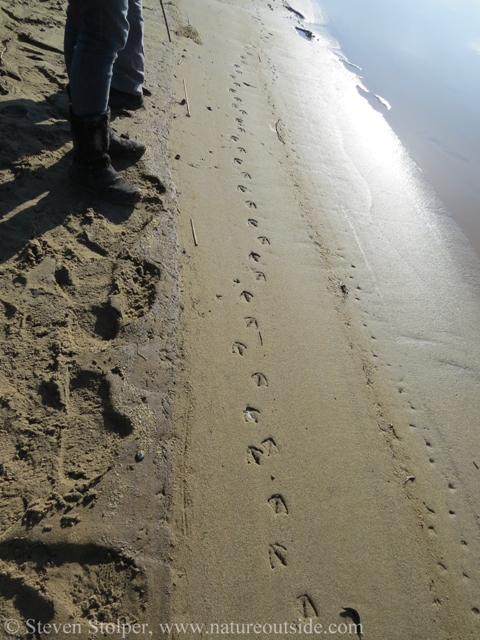
Ducks or gulls?
Black Turnstone
Seeing an unfamiliar bird is exciting for me. One of the trackers introduced me to the Black Turnstone. It lives along the rocky ocean coast where its coloring blends well with the terrain. Below is a picture where you can easily see the birds. But I took several where I had to spend a moment to figure out exactly how many birds were in the picture.
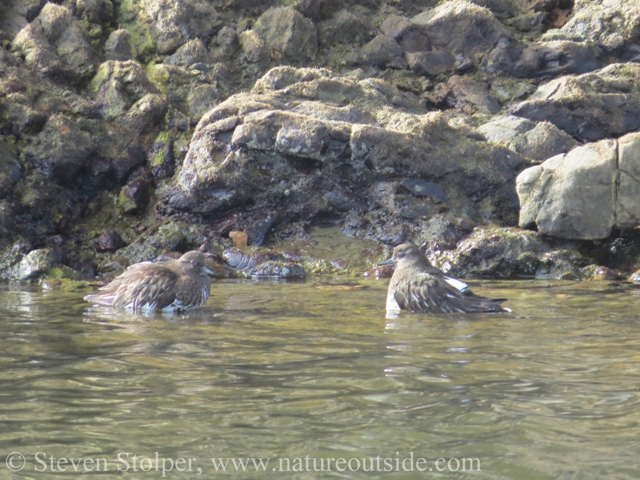
Black Turnstones
More Questions than Answers
No one is dumb who is curious. The people who don’t ask questions remain clueless throughout their lives.
– Neil deGrasse Tyson
It was a tremendously exciting day at the beach. We had mysteries to solve and, as usual, left with more questions than answers. I can’t wait to do it again!
More Tracking on NatureOutside
Mysteries on The Beach (Part 1)
Mountain Lion Tracks – Learn to Read Them
Wolves Teach a Master Class (Part 1)
For fun facts and useful tips, join the free Bushcraft Newsletter.

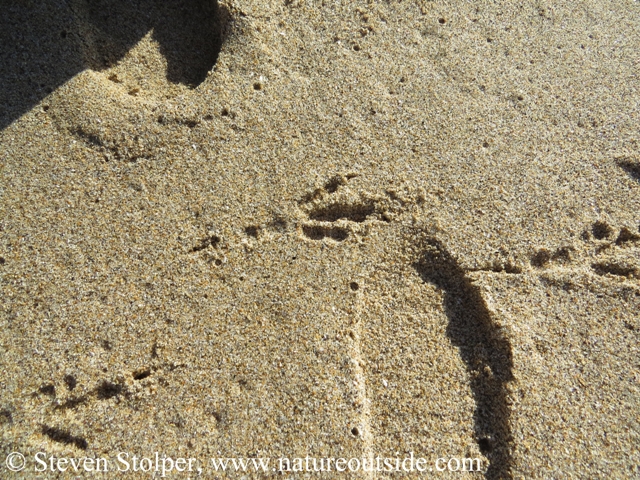


While I was not there, I am so enjoying the write-ups & learning a lot! Thank you!
I’m glad you liked the write-ups, Lisa!